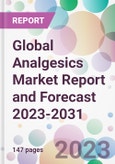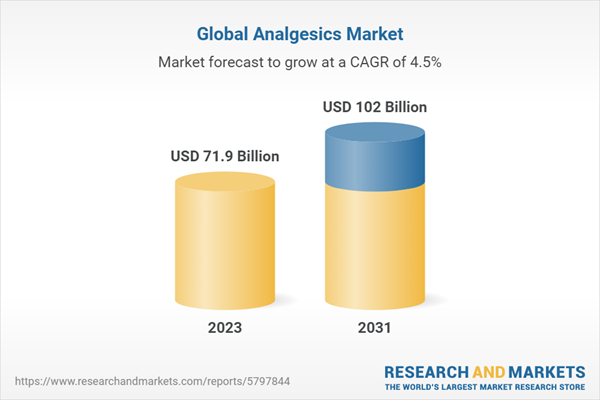The global analgesics market size attained a value of USD 68.8 billion in 2022. The market is anticipated to grow at a CAGR of 4.5% during the forecast period of 2023-2031 to attain a value of USD 102 billion by 2031.
There are several types of analgesics, including nonsteroidal anti-inflammatory drugs (NSAIDs), acetaminophen, and opioids. NSAIDs work by blocking the production of prostaglandins, which are chemicals that cause inflammation and pain. Acetaminophen works by blocking pain signals in the brain, while opioids work by binding to opioid receptors in the brain and spinal cord, reducing the perception of pain.
The benefits of analgesics are numerous. They can help to relieve pain and improve quality of life for individuals suffering from acute or chronic pain. By reducing pain, analgesics can also help to improve sleep, reduce stress, and enhance overall well-being.
In addition to relieving pain, some analgesics also have anti-inflammatory properties, which can help to reduce swelling and inflammation associated with conditions such as arthritis and injuries.
However, it is important to use analgesics safely and according to the instructions of a healthcare provider. Overuse or misuse of analgesics can lead to adverse side effects, including liver damage, stomach ulcers, and addiction to opioids.
Overall, analgesics are an important tool for managing pain and improving quality of life for individuals suffering from a variety of conditions. When used safely and appropriately, they can provide significant relief from pain and enhance overall well-being.
The market for analgesics is highly competitive, with many players offering a wide range of products to cater to the diverse needs of healthcare providers and patients. The market is segmented based on product type, pain type, distribution channel, and geography.
Based on product type, the market is divided into opioids, nonsteroidal anti-inflammatory drugs (NSAIDs), acetaminophen, and others. NSAIDs are the largest segment of the market, with a high demand for over-the-counter products such as ibuprofen and naproxen. Opioids are also an important segment of the market, particularly for individuals with moderate to severe pain.
Based on pain type, the market is divided into neuropathic pain, cancer pain, arthritic pain, and others. Neuropathic pain is the largest segment of the market, driven by the high prevalence of conditions such as diabetic neuropathy and postherpetic neuralgia.
Based on distribution channel, the market is divided into hospitals, clinics, retail pharmacies, and online pharmacies. Retail pharmacies are the largest distribution channel segment of the market, owing to the widespread availability of over-the-counter analgesics and the convenience of obtaining these products.
The market for analgesics is expected to continue to grow in the coming years, driven by the increasing prevalence of acute and chronic pain, as well as the growing demand for effective pain management options. Advances in technology and research are expected to lead to the development of new and innovative treatments, which may provide more effective options for patients suffering from pain.
Overall, the analgesics market is an important component of the healthcare system, providing patients with access to a wide range of pain management options. When used safely and appropriately, analgesics can provide significant relief from pain and enhance overall well-being.
Analgesics Market: Introduction
Analgesics are a type of medication used to relieve pain. They work by blocking pain signals to the brain or by reducing inflammation, which can cause pain. Analgesics are commonly used to treat pain from a variety of conditions, including headaches, arthritis, menstrual cramps, and injuries.There are several types of analgesics, including nonsteroidal anti-inflammatory drugs (NSAIDs), acetaminophen, and opioids. NSAIDs work by blocking the production of prostaglandins, which are chemicals that cause inflammation and pain. Acetaminophen works by blocking pain signals in the brain, while opioids work by binding to opioid receptors in the brain and spinal cord, reducing the perception of pain.
The benefits of analgesics are numerous. They can help to relieve pain and improve quality of life for individuals suffering from acute or chronic pain. By reducing pain, analgesics can also help to improve sleep, reduce stress, and enhance overall well-being.
In addition to relieving pain, some analgesics also have anti-inflammatory properties, which can help to reduce swelling and inflammation associated with conditions such as arthritis and injuries.
However, it is important to use analgesics safely and according to the instructions of a healthcare provider. Overuse or misuse of analgesics can lead to adverse side effects, including liver damage, stomach ulcers, and addiction to opioids.
Overall, analgesics are an important tool for managing pain and improving quality of life for individuals suffering from a variety of conditions. When used safely and appropriately, they can provide significant relief from pain and enhance overall well-being.
Analgesics Market Segmentations
The market can be categorised into type, drug class, route of administration, pain type, application, end user, and region.Market Breakup by Type
- Prescription Analgesics
- OTC Analgesics
Market Breakup by Drug Class
- Opioids
- NSAID
- Others
Market Breakup by Route of Administration
- Oral
- Parenteral
- Topical
- Transdermal
- Rectal
Market Breakup by Pain Type
- Musculoskeletal Pain
- Surgical and Trauma Pain
- Cancer Pain
- Neuropathic Pain
- Migraine
- Obstetrical Pain
- Fibromyalgia
- Pain due to burns
- Dental/Facial Pain
- Pediatric Pain
- Others
Market Breakup by Application
- Internal Analgesics
- External Analgesics
Market Breakup by End User
- Hospital Pharmacy
- Retail Pharmacy
- Other
Market Breakup by Region
North America
- United States of America
- Canada
Europe
- United Kingdom
- Germany
- France
- Italy
- Others
Asia Pacific
- China
- Japan
- India
- ASEAN
- Australia
- Others
Latin America
- Brazil
- Argentina
- Mexico
- Others
Middle East and Africa
- Saudi Arabia
- United Arab Emirates
- Nigeria
- South Africa
- Others
Analgesics Market Scenario
The global market for analgesics is expected to experience steady growth in the coming years, driven by the increasing prevalence of acute and chronic pain, as well as the growing demand for effective pain management options. Analgesics are a type of medication used to relieve pain and can be prescribed or obtained over the counter.The market for analgesics is highly competitive, with many players offering a wide range of products to cater to the diverse needs of healthcare providers and patients. The market is segmented based on product type, pain type, distribution channel, and geography.
Based on product type, the market is divided into opioids, nonsteroidal anti-inflammatory drugs (NSAIDs), acetaminophen, and others. NSAIDs are the largest segment of the market, with a high demand for over-the-counter products such as ibuprofen and naproxen. Opioids are also an important segment of the market, particularly for individuals with moderate to severe pain.
Based on pain type, the market is divided into neuropathic pain, cancer pain, arthritic pain, and others. Neuropathic pain is the largest segment of the market, driven by the high prevalence of conditions such as diabetic neuropathy and postherpetic neuralgia.
Based on distribution channel, the market is divided into hospitals, clinics, retail pharmacies, and online pharmacies. Retail pharmacies are the largest distribution channel segment of the market, owing to the widespread availability of over-the-counter analgesics and the convenience of obtaining these products.
The market for analgesics is expected to continue to grow in the coming years, driven by the increasing prevalence of acute and chronic pain, as well as the growing demand for effective pain management options. Advances in technology and research are expected to lead to the development of new and innovative treatments, which may provide more effective options for patients suffering from pain.
Overall, the analgesics market is an important component of the healthcare system, providing patients with access to a wide range of pain management options. When used safely and appropriately, analgesics can provide significant relief from pain and enhance overall well-being.
Key Players in the Global Analgesics Market
The report gives an in-depth analysis of the key players involved in the analgesics market, sponsors manufacturing the drugs, and putting them through trials to get FDA approvals. The companies included in the market are as follows:- Bayer AG
- GlaxoSmithKline plc
- Pfizer Inc
- Sanofi
- F. Hoffmann-La Roche Ltd
- Endo Pharmaceuticals, Inc
- Bristol-Myers Squibb Company
- Assertio Therapeutics, Inc
- Janssen Pharmaceuticals
- Novartis AG
- Teva Pharmaceuticals
- AbbVie Inc
- Purdue Pharmaceuticals L.P
- Boehringer Ingelheim International GmbH
Table of Contents
1 Preface
3 Global Analgesics Market Overview
4 Global Analgesics Market Landscape
5 Global Analgesics Market Dynamics
6 Global Analgesics Market Segmentation
7 North America Analgesics Market
8 Europe Analgesics Market
9 Asia Pacific Analgesics Market
10 Latin America Analgesics Market
11 Middle East and Africa Analgesics Market
12 Patent Analysis
13 Grants Analysis
14 Funding Analysis
15 Partnership and Collaborations Analysis
16 Regulatory Framework
17 Supplier Landscape
18 Global Analgesics Market - Distribution Model (Additional Insight)
20 Company Competitiveness Analysis (Additional Insight)
21 Payment Methods (Additional Insight)
Companies Mentioned
- Bayer AG
- GlaxoSmithKline plc.
- Pfizer Inc.
- Sanofi
- F. Hoffmann-La Roche Ltd.
- Endo Pharmaceuticals, Inc.
- Bristol-Myers Squibb Company
- Assertio Therapeutics, Inc.
- Janssen Pharmaceuticals
- Novartis AG
- Teva Pharmaceuticals
- Abbvie Inc.
- Purdue Pharmaceuticals L.P.
- Boehringer Ingelheim International Gmbh
Methodology

LOADING...
Table Information
| Report Attribute | Details |
|---|---|
| No. of Pages | 147 |
| Published | April 2023 |
| Forecast Period | 2023 - 2031 |
| Estimated Market Value ( USD | $ 71.9 Billion |
| Forecasted Market Value ( USD | $ 102 Billion |
| Compound Annual Growth Rate | 4.5% |
| Regions Covered | Global |
| No. of Companies Mentioned | 14 |









